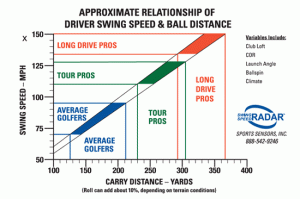Chips from twenty yards or so can be the most troublesome shots in golf. They come in four varieties, based on the ratio of distance to the green and distance from there to the pin. I’m going to tell you how to hit each one.
1. Ten yards to the green, ten yards to the pin. Here, the distances are equal, but they are long distances. You need a moderately-lofted club, like a pitching wedge, to get the ball to the edge of the green but not run out way past the hole.
2. Ten yards to the green, five yards to the pin. Use a gap wedge to get the ball to the edge of the green and sitting quickly. The stroke is specialized: hit the shot by sliding the club underneath the ball, keeping the clubhead low at all times, especially on the follow-through, to get maximum spin.
3. Five yards to the green, ten (or more) yards to the pin. Use a 7- or 8-iron to get the ball on the green and running up to the hole.
4. Fifteen yards to the green, five yards to the pin. Use a sand wedge. This another specialized stroke. Power the downswing only with gravity, using your hands to guide the club into the ball. Emphasize hitting the ground directly underneath the ball with the sole of your club. When struck properly, the ball floats up, floats down, and dies right away. This shot takes practice.
If you have a tight lie for any of these shots, odds are you have good ground all the way up to the green. If so, and there are no obstacles to hit over, use a straighter-faced club and run the ball all the way to the pin.
With a tight lie and something you have to hit over, like a bunker or thick grass, play the ball back in your stance. Pinch the ball off the turf with a lofted wedge. Think only of getting the ball on the green so you can start putting.

